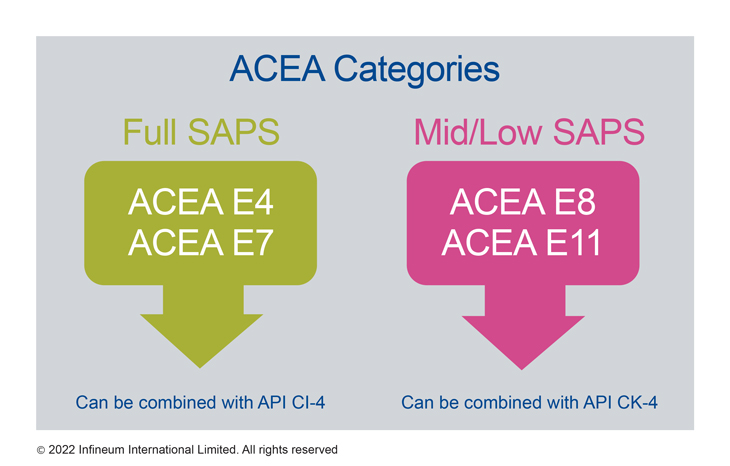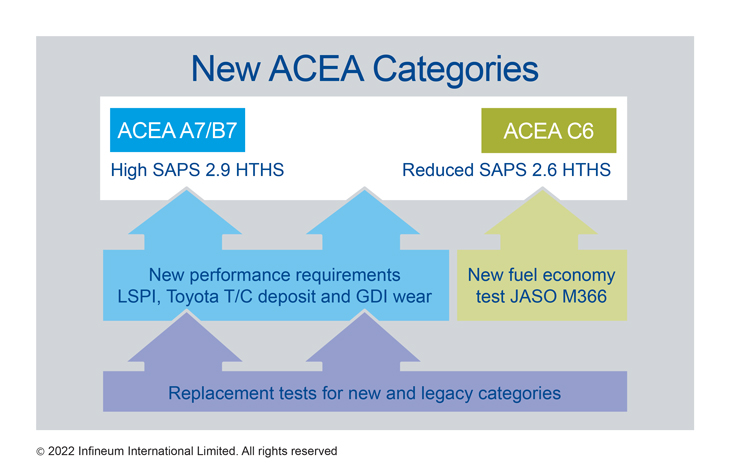Passenger cars
Severe hybrid engine oil testing
20 May 2025
09 August 2022
What the key changes in the revisions to the ACEA Oil Sequences for heavy- and light-duty engines mean

The European Automobile Manufacturers’ Association, ACEA, which unites Europe’s 16 major car, truck, van and bus makers, has been working hard, along with the wider lubricants, additive and testing industries, to agree the revisions to both the light- and heavy-duty oil sequences for service fill oils. Now that both sets of oil sequences and their supporting documentation are live, Insight takes time to explore the changes, which have been carefully designed to both protect the latest vehicle hardware and to ensure engine tests are maintained.
Click here to access the Infineum ACEA Oil Sequences brochure.
What are the ACEA Oil Sequences?
The ACEA Oil Sequences for service fill engine oils are in place for light-duty gasoline and diesel engines, either with or without aftertreatment devices, and for heavy-duty diesel engines. They define the minimum quality level of an oil product for self-certification to the European Engine Lubricants Quality Management System (EELQMS) and for presentation to ACEA members.
Why were the ACEA Oil Sequences modified?
The latest ACEA Oil Sequences have been designed to address the lubrication needs of engine developments that are being driven by both regulatory and performance requirements and to incorporate necessary maintenance to the tests used.
Example changes include the creation of ACEA C6 to address low-speed pre-ignition (LSPI) issues and turbocharger fouling in modern light-duty engines and, for heavy-duty engines, the OM501LA engine test was replaced by OM471 in ACEA E4 and E8.
Who has been involved in the revisions to the ACEA Oil Sequences?
Replacement tests and other changes were identified by the Association’s 16 automaker members: BMW Group, DAF, Daimler Truck, Ferrari, Hyundai, Mercedes Benz, Toyota, Ford, Iveco Group, Groupe Renault, Volkswagen Group, Stellantis, Volvo Group, Volvo Trucks, Honda, Jaguar Land Rover. ACEA worked in close cooperation with representatives of the lubricant industry (ATIEL), chemical additive companies (ATC) and engine testing laboratories to develop the revised industry standards.
Why are there three documents covering ACEA Oil Sequences?
One file details the technical requirements for the 2021 ACEA Oil Sequences for light-duty engines, another details the technical requirements for the 2022 ACEA Oil Sequences for heavy-duty engines and a third file is a General Requirements document, which addresses issues common to both the light-duty and heavy-duty ACEA Oil Sequences.
2022 ACEA Oil Sequences for heavy-duty engines
When did the new ACEA Oil Sequences for heavy-duty engines become valid and when do the 2016 ACEA Oil Sequences for heavy-duty engines become obsolete?
The new ACEA Oil Sequences for heavy-duty engines were published on 1 May 2022 and will become mandatory for new claims from 1 May 2023. Oils with claims to the 2016 Oil Sequences may be marketed until 1 May 2024.
What are the key changes vs the 2016 ACEA Oil sequences?
In the 2022 ACEA Oil Sequences for heavy-duty engines, the ACEA E7 and E4 full SAPS categories, which can typically be combined with API CI-4 are being maintained.
New ACEA E8 and E11, mid/low SAPS, categories have been built on ACEA E6-16 and E9-16 respectively and can typically be combined with API CK-4. These have been upgraded to a different performance level where the main changes are the higher oxidation requirements and improved aeration performance.

Have new engine tests been introduced?
In the 2022 ACEA Oil Sequences for heavy-duty engines, the OM471 engine test has been introduced in ACEA E4 and E8 categories as a replacement for the OM501LA piston cleanliness test. While it is mandatory in ACEA E8, OM501LA results remain an alternative to demonstrate compliance in ACEA E4.
In the ACEA E8 and E11 categories, the Volvo T-13 (ASTM D8048) oxidation stability test has been introduced to ensure extended oil drain performance. Aeration in direct injection, turbocharged diesel engines will be screened by the COAT (ASTM D8047) test.
How do the ACEA Oil Sequences support fuel economy performance?
The ACEA F categories can be expected in future updates to the ACEA Oil Sequences for heavy-duty engines, which intend to include lower viscosities (HTHS @ 150 °C between 2.9 and 3.2 mPa.s) in order to support OEMs looking for fuel economy gains.
2021 ACEA Oil Sequences for light-duty engines
When did the new ACEA Oil Sequences for light-duty engines become valid and when do the 2016 ACEA Oil Sequences for light-duty engines become obsolete?
The ACEA light-duty sequences were published on 30 April 2021 and became mandatory for new claims from 1 May 2022. Oils with claims to the 2016 Oil Sequences may be marketed until 1 May 2023.
In 2022, ACEA made a small revision to the 2021 ACEA Oil Sequences for light-duty engines to clarify that TBN measurements are not required for the ACEA C2-21 category, and is consistent with the ACEA C2-16 category.
What were the key changes vs ACEA 2016?
In the 2021 ACEA Oil Sequences for light-duty engines, the ACEA A3/B3 and C1 categories were withdrawn and new ACEA A7/B7 and C6 categories were introduced.
The full sulphated ash phosphorus and sulphur (SAPS) ACEA A7/B7 category is designed to provide low speed pre-ignition (LSPI) and wear protection for turbocharged direct injection (DI) gasoline engines and turbocharger compressor deposit (TCCD) protection for modern DI diesel engines.
The low SAPS ACEA C6 category provides LSPI and wear protection for turbocharged DI gasoline engines and TCCD protection and is compatible with catalyst, gasoline and diesel particulate filter (GPF/DPF) exhaust aftertreatment systems. This category also ensures fuel economy (FE) with the introduction of the JASO M366 FE test.

Were new tests introduced and is their use mandatory?
In the 2022 ACEA Oil Sequences for light-duty engines, the Sequence VH at API SP limits replaces the Sequence VG at SM limits.
The M271EVO replaces M271 ‘Classic’ for black sludge control and the VW TDI3 replaces the current TDI test for diesel piston cleanliness. While it is still possible to use their predecessors to claim ACEA categories it should be noted that the M271EVO is mandatory for the new ACEA A7/B7 and C6 categories, which means the ‘classic’ test is only valid for legacy categories.
Sequence IVB was introduced to prevent valvetrain wear, an issue that has remained unaddressed since the withdrawal of the TU3-MS engine test in ACEA-2016. This engine test, borrowed from the API S categories, allows results from the Sequence IVA engine test for legacy categories (i.e. all but ACEA A7/B7 and C6).
How do the ACEA Oil Sequences support fuel economy performance?
In the 2022 ACEA Oil Sequences for light-duty engines, the new C6 category provides LSPI and wear protection for engines using lower viscosity SAE xW-20 viscosity grades, giving OEMs high fuel economy potential. Fuel economy performance is still assessed in the M111FE engine test for all categories except ACEA C6, which sees the introduction of the JASO M366 FE engine test.
What has Infineum done regarding the new ACEA Oil Sequences?
Infineum has already completed all engine and bench testing requirements to upgrade relevant heavy-duty and light-duty engine oil products to the latest ACEA Oil Sequences.
In addition, we have produced a new brochure covering the latest ACEA Oil Sequences for heavy-duty and light-duty engines, which provides details on the changes that have been made, conditions for use, dates for first allowable use, mandatory use and dates that oils with ACEA claims may be marketed until. It also contains tables of requirements, test methods, properties, and limits along with information on nomenclature and consumer language.
Click here to access the Infineum ACEA Oil Sequences brochure.
Sign up to receive monthly updates via email